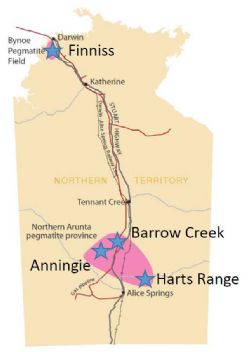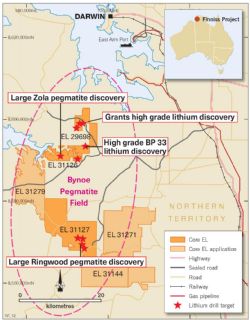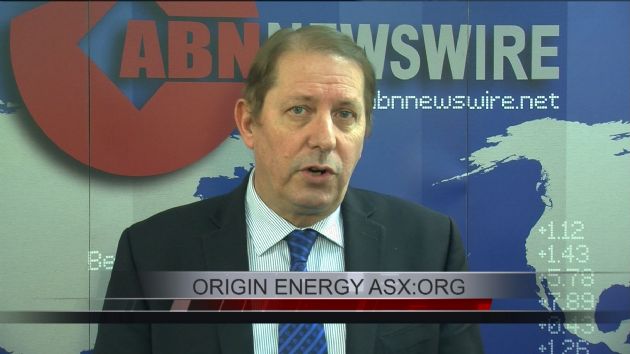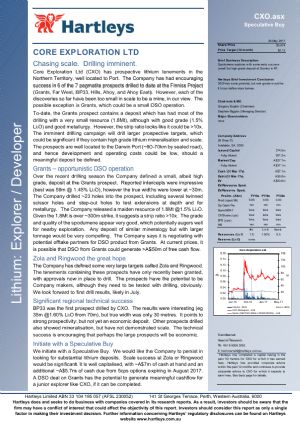 Quarterly Activities and Cashflow Report 30 September 2016
Quarterly Activities and Cashflow Report 30 September 2016
Adelaide, Oct 31, 2016 AEST (ABN Newswire) - The Board of Core Exploration Ltd ( ASX:CXO) ("Core" or "Company") is pleased to present its Quarterly activities report for the Period ended 30 September 2016.
ASX:CXO) ("Core" or "Company") is pleased to present its Quarterly activities report for the Period ended 30 September 2016.
Highlights
High grade spodumene intersections in Core's maiden lithium drilling program during the reporting period at the Finniss Lithium Project ("Finniss") in the Northern Territory has confirmed Finniss, as a major new discovery of high grade lithium.
With the granting of EL 31126 and EL 31127 at Finniss Core now holds the largest lithium tenure position in the NT, including the highest grade lithium drill intersections, the largest historic pegmatite mine and at least another 25 other recorded pegmatite mines in the Northern territory.
Core is also pleased to confirm that recently acquired tenement EL 29698, which includes each of the recently drilled prospects, has now been transferred and registered to Core.
The discovery of high grade zones of lithium with this current drill program is very significant for Core given the scale of some of the new pegmatites identified by Core are directly comparable to the scale of pegmatites hosting large lithium resources in Western Australia.
Core has a current cash position of approximately $10 million including funds received from recent oversubscribed SPP.
Lithium Projects in the NT
Core has continued to expand and consolidate its strategic lithium projects in pegmatite provinces in the NT during 2016 and has a strong diversity of lithium projects with a range of exploration maturities.
The focus of Cores' activity during the reporting period has been on Core's Finniss Lithium Project near Darwin where high grade spodumene intersections in Core's maiden lithium drilling program has confirmed Finniss, as a major new discovery of high-grade lithium.
The Finniss Lithium has substantial infrastructure advantages; being close to grid power, gas and rail and within easy trucking distance by sealed road to Darwin Port - Australia's nearest port to Asia.
Core has also appointed specialist-engineering consultants Como Engineers to manage the proposed metallurgical test work and provide early engineering advice to the Finniss Lithium Project.
Grants Prospect RC Drilling Results
The highest lithium grade intersections ever drilled in the NT were made at the Grants Prospect drilled in Core's maiden drilling program during the quarter at Finniss.
Results from assays to date from the Grants Prospect include:
- 49m @ 1.78% Li2O from 71m (FRC007) including:
-- 6m @ 2.26% Li2O from 97m
-- 9m@ 2.05% Li2O from 110m
- 31m @ 1.61% from 68m (FRC0017), including:
-- 4m @ 2.01% from 83m
- 40m @ 1.66% Li2O from 58m (FRC0018), including:
-- 10m @ 2.02% Li2O from 65m
-- 5m @ 2.05% Li2O from 84m
-- 1m @ 3.23% Li2O from 85m
The second prospect drilled by Core in its maiden drilling program at the Finniss Lithium Project was the Grants prospect, where six holes were drilled.
The best result was 1.78% Li2O over 49m, containing zones of high-grade spodumene mineralisation of up to 9m @ 2.05% Li20 (drill hole FRC007). Other holes at Grants also returned zones of high-grade lithium as listed in Table 1 in the link below.
All holes hit pegmatite intersections over broad intervals of 30-50 metre widths (approximately 20-30m true width), containing high grades of lithium as spodumene mineralisation (see Table 1 and Figures 3-4 in the link below).
The Grants Pegmatite outcrops for over 350m at surface, is consistently intersected in all drill sections, and is open to the north and south.
Grants is ideally located less than 1km from Highway 34, which connects the Finniss Lithium Project by high quality, sealed road to the Port of Darwin. Core's high-grade drill intersections at Grants are located less than 25km from the Port of Darwin.
BP33 Prospect RC and Diamond Core Drilling Results
The first prospect drilled by Core at Finniss was the BP33 prospect, where four holes were drilled with all holes hitting pegmatite intersections over broad 40-60 metres (approximately 30-35m true width), containing high grades of lithium as spodumene mineralisation (see Tables 2 and Figures 5-6 in the link below).
The best result was 1.60% Li2O over 34m, containing zones of high-grade spodumene mineralisation of up to 7m @ 2.02% Li20 (drill hole FRC003). The other three holes at BP33 also returned zones of high-grade lithium. Results are listed in Table 2 in the link below.
Initial observations of the BP33 core show that high-grade lithium as spodumene is almost ubiquitous throughout the first 40m fully cored pegmatite drill intersection (see Figure 5-6 in the link below).
As a result, Core has immediately commenced preparation for this large diameter HQ core and additional cored drillholes at Grants (once completed) to be sent for metallurgical test work to determine their potential to produce commercial grade spodumene concentrate.
Spodumene mineralisation is relatively consistent for most of the 40m of continuous pegmatite intersected from 80m downhole, if approximately metre-scale pegmatite margins and quartz cores are disregarded.
Spodumene crystals vary in colour from pale green, pink, dull yellow and also some white varieties are present. No other lithium minerals appear evident, such as amblygonite or lepidolite (see Figures 5-6 in the link below). On preliminary inspection it appears that, the pegmatite at BP33 comprises only a few simple minerals, in overall order of abundance: feldspar, spodumene, quartz and muscovite (less than 5%).
The BP33 prospect is located approximately 150m north of BP32 and 200m NE of BP32W. It is likely that all these pegmatite bodies are part of a larger interconnected pegmatite swarm, and Core plans to drill these prospects with subsequent phases of drilling at Finniss. BP33 pegmatite has been mined historically from surface down to 10-20m for tin and tantalum (see Figures 5 and 6 in the link below).
Zola Prospect
Reconnaissance mapping and careful research of historic reports by Core during the reporting period has uncovered several large un-documented or poorly documented pegmatites.
The large-scale Zola Pegmatite Prospect on newly granted EL 31126 includes a north-south trending swarm of pegmatites covering an area conservatively estimated at between 1-2 square kilometres (see Figures 7 in the link below).
The most important aspect of Zola is the scale (see Figure 7 in the link below). The outcrop of decomposed pegmatite and quartz blows extend for up to 1,500 m NS and could be as long as 2,000m under cover (abundant quartz in road-cutting to the north - see Figure 7 in the link below). Pegmatite material extends EW for at least 450m at surface, suggesting a substantial swarm of highly fractionated pegmatites.
The scale of the Zola Pegmatite prospect is directly comparable to the scale of pegmatites hosting large resources in the Pilgangoora region in Western Australia (see Figure 7 in the link below).
In the 1980's, Union Oil and JV partner Kakadu excavated a total of seven costeans (approximately 1000m) across the pegmatite zone.
Ringwood Prospect
During the reporting period, Core discovered an additional large pegmatite swarm within the Finniss Lithium Project near Darwin in the NT.
The Ringwood Pegmatite Swarm together with the previously announced large pegmatite find at Zola are expected to add substantial scale and upside to Core's Finniss Lithium Project. Ringwood, Zola and other large pegmatites discovered by Core at Finniss are directly comparable to the scale of lithium pegmatites in Western Australia.
The Ringwood Pegmatite Swarm presents as pegmatite and quartz outcrop and float extends at least 2,000m long and 800m wide (see Figure 8 in the link below).
Ringwood is positioned within a 6,000m long trend of previously unmapped pegmatites north from Mt Finniss Mine NT's largest historically producing pegmatite mine that is also within Core's Project. Spodumene mineralisation has also been recently drilled to the north of the Ringwood trend by Liontown ( ASX:LTR) at the Sandra's Pegmatite (see Figures 8-9 in the link below).
ASX:LTR) at the Sandra's Pegmatite (see Figures 8-9 in the link below).
Anningie and Barrow Creek Lithium Projects, NT
Core's Anningie and Barrow Creek Lithium Projects. Encompass four Exploration Licence applications covering approximately 2,500 square kilometres in and around the Anningie and Barrow Creek Tin Tantalum Pegmatite fields in the north Arunta Region of the NT, which are considered highly prospective for lithium.
NORTHERN ARUNTA PEGMATITE PROVINCE
The Northern Arunta pegmatite province occurs in well-defined clusters in the Barrow Creek and Anningie pegmatite fields (see Figure 10 in the link below). The mineralised pegmatites typically occur in linear swarms and range in size from a few metres long and less than a metre wide up to hundreds of metres long and tens of metres wide.
The first reported occurrence of alluvial tin mining from tin-bearing pegmatites in the Arunta Region was not until 1935, when shallow alluvial deposits were worked on leases southwest of Barrow Creek Township at what was to become the Anningie Tin Field.
As with Greenbushes in WA, before economic lithium was recognised, the northern Arunta also has a long history of tin and tantalum mining. It is also evident that the pegmatites in the Anningie and Barrow Creek fields are enriched with lithium as evidenced by economic lithium minerals spodumene as well as highly elevated lithium in geoscientific sampling of source granites and pegmatites.
To date lithium has not been explored for in the north Arunta and the potential of the area is yet to be properly assessed given all of the historical work only focused on tin-tantalum. The pegmatites that have been recognised and exploited to date are only the near surface expression and there is high potential for larger mineralised bodies at depth.
Anningie Pegmatite Field
The Anningie Tin Field is located southwest of TNG Ltd's ( ASX:TNG) Mt Peake Vanadium Project approximately 80km west of Barrow Creek in NT (see Figure 10 in the link below).
ASX:TNG) Mt Peake Vanadium Project approximately 80km west of Barrow Creek in NT (see Figure 10 in the link below).
Alluvial tin was discovered at the site of what was to become the Reward Lease in 1935.
The lithium minerals spodumene, elbaite and lepidolite are reported to occur in pegmatite a few kilometres east of the Anningie Tin Field.
Located toward the centre of the field, the Reward mine (within excised area - see Figure 10 in the link below) is reported to contain the largest of the tin-tantalum bearing pegmatites (~200 m long and ~10-20 m wide). The main workings occurred in alluvium and that mineralisation was the result of the shedding of tin-tantalum from outcropping pegmatite dykes.
The Reward pegmatite was sampled by the NTGS (~circa 2004) and analysed for major- and trace-element chemistry. The NTGS report states that Reward pegmatite clearly has the most favourable chemistry of all the North Arunta pegmatites. Lithophile trace elements Rb, Cs and Li, are consistently high and also more elevated in Ta, Nb, Sn and Li, than the other pegmatites sampled in the suite.
Barrow Creek Pegmatite Field
A number of tin-tantalum-bearing pegmatites intrude the Palaeoproterozoic Bullion Schist within 30 km of Barrow Creek.
Tin tantalum concentrate production commenced in the 1940's from the Barrow Creek pegmatite field from weathered pegmatite and elluvium.
The source granite for the pegmatites is considered to be 1713 Ma, fractionated S-type Barrow Creek Suite, which occurs as apophyses throughout the Barrow Creek area (see Fig 10 in the link below).
NTGS and other geoscientific research highlights that the Barrow Creek Suite source granites have enriched lithium contents comparable with the highest lithium granites in the NT.
Proposed Activities Next Quarter
Finniss Lithium Project, NT
Core has commenced immediate follow-up of the recently announced high-grade spodumene discoveries at Grants and BP33 Prospects on the Finniss Lithium Project near Darwin in the NT.
The first diamond drilling program at Finniss is underway and acquiring the first fully cored spodumene intersections in the Bynoe Field through these highly mineralised pegmatites.
A second phase of RC drilling is also planned to commence shortly at Finniss to both follow up and also to further explore the scale of lithium mineralisation discovered so far by Core's first drilling program.
Core plans to undertake concentrate test-work on the mineralised high-grade core from diamond drilling to potentially produce commercial grade spodumene concentrate. This metallurgical test-work as well as early engineering studies will be another key step forward toward evaluating the economics of the Finniss Lithium Project.
Anningie and Barrow Creek Lithium Project, NT
Core will continue the Company's reconnaissance exploration work on this highly prospective early stage lithium project.
To view the full report, please visit:
http://abnnewswire.net/lnk/ZW7UG917
About Core Lithium Ltd
 Core Lithium Ltd (ASX:CXO) is an Australian hard-rock lithium company that owns the Finniss Lithium Operation on the Cox Peninsula, south-west and 88km by sealed road from the Darwin Port, Northern Territory. Core's vision is to generate sustained shareholder value from critical minerals exploration and mining projects underpinned by strong environmental, safety and social standards.
Core Lithium Ltd (ASX:CXO) is an Australian hard-rock lithium company that owns the Finniss Lithium Operation on the Cox Peninsula, south-west and 88km by sealed road from the Darwin Port, Northern Territory. Core's vision is to generate sustained shareholder value from critical minerals exploration and mining projects underpinned by strong environmental, safety and social standards.

![abnnewswire.com]()
Related Companies
Social Media
Share this Article

 ASX:CXO) ("Core" or "Company") is pleased to present its Quarterly activities report for the Period ended 30 September 2016.
ASX:CXO) ("Core" or "Company") is pleased to present its Quarterly activities report for the Period ended 30 September 2016.  ASX:LTR) at the Sandra's Pegmatite (see Figures 8-9 in the link below).
ASX:LTR) at the Sandra's Pegmatite (see Figures 8-9 in the link below).  ASX:TNG) Mt Peake Vanadium Project approximately 80km west of Barrow Creek in NT (see Figure 10 in the link below).
ASX:TNG) Mt Peake Vanadium Project approximately 80km west of Barrow Creek in NT (see Figure 10 in the link below).  Core Lithium Ltd (ASX:CXO) is an Australian hard-rock lithium company that owns the Finniss Lithium Operation on the Cox Peninsula, south-west and 88km by sealed road from the Darwin Port, Northern Territory. Core's vision is to generate sustained shareholder value from critical minerals exploration and mining projects underpinned by strong environmental, safety and social standards.
Core Lithium Ltd (ASX:CXO) is an Australian hard-rock lithium company that owns the Finniss Lithium Operation on the Cox Peninsula, south-west and 88km by sealed road from the Darwin Port, Northern Territory. Core's vision is to generate sustained shareholder value from critical minerals exploration and mining projects underpinned by strong environmental, safety and social standards.




















